Shortly after moving in, the new owner of this 1950's-era ranch observed heavy efflorescence on the exposed brick chimney shaft in his living room and on the adjacent ceiling. A new roof had just been installed by a reputable contractor (Warner Nelson at Star Roofing & Siding) so we knew the roof was not the culprit.
The new owner had been told that the rebuilt chimney was about a decade old (that's considered a young chimney by our standards), so we popped up onto the roof to have a better look. A close-up inspection revealed a concrete chimney cap cracked in multiple places and very poor mortar adhesion between the bricks (this can happen when ambient temperatures during construction are too high so the mortar dries too rapidly, when the mortar freezes before it has completely cured, or when the mortar has not been mixed correctly). After we removed the roof flashing at the base of the chimney, we were surprised at the extent of the brick erosion and failed mortar.
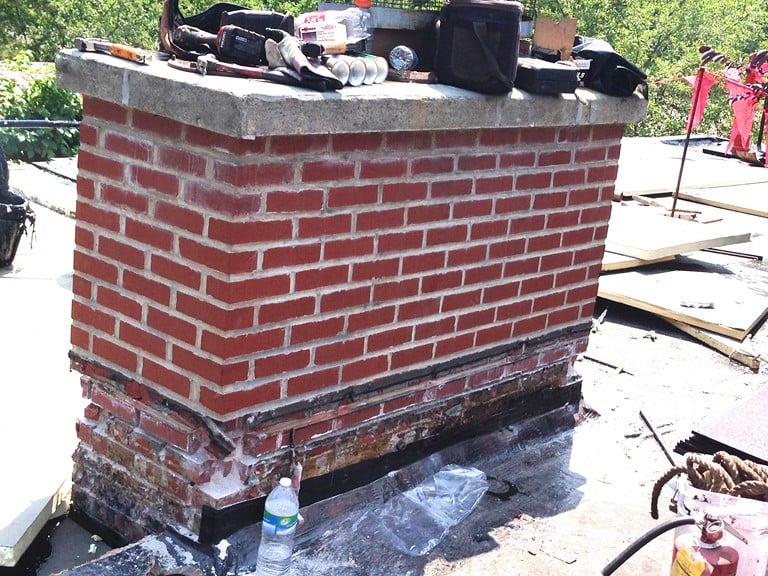
As we dismantled the chimney we were disappointed to see how the previous mason had elected to rebuild the structure. It was a mess. The mortar contained much too much Portland cement, making the mortar too hard for the bricks and virtually guaranteeing the chimney's early demise; improperly sized flue tiles had been used creating a drafting issue (and, potentially, a carbon monoxide issue); and cinder blocks had been used indiscriminately. (We are not fans of cinder block construction.)
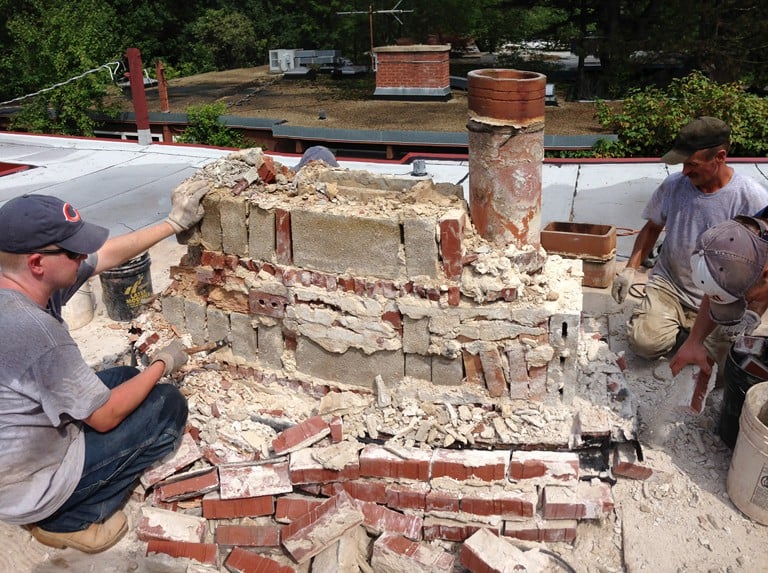
After dismantling the defective chimney down to the roof deck, we set about rebuilding the chimney the correct way:
- We used Belden bricks (some of the best clay pits in America are located in Belden, Ohio). These Belden Colony Red Range bricks are more than double the cost of similar looking bricks but will last for generations…the way all bricks should perform. An added benefit was the spot-on color match with the brick facade which the new owner appreciated.
- We used only Type N mortar, which provided the right balance between strength and softness so that the bricks will not spall or crack apart prematurely.
- We worked within the right temperature range so that the mortar cured slowly and appropriately and bonded well to the bricks. (We wetted the bricks as we worked just to be sure.)
- We saved the owner the cost of replacing the metal rain caps because they were in structurally sound condition and could be re-used.
- We cleaned up the job site and removed all traces of debris so that the roofer could return to permanently re-flash the base of the chimney using modified roof flashing and galvanized counter-flashing.
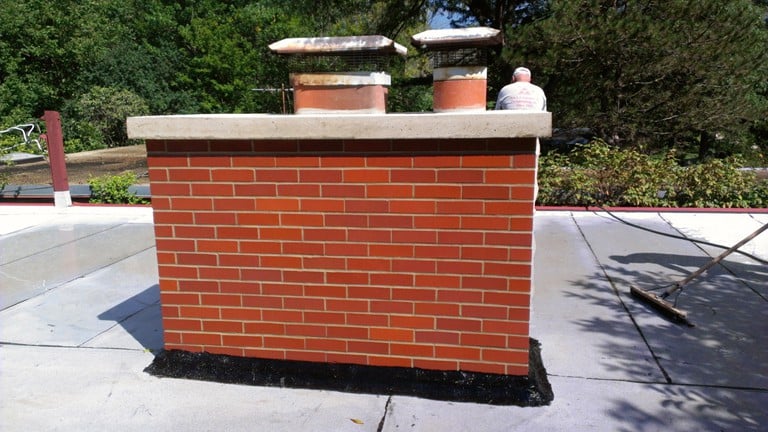
Whether your project is a residential chimney or a mile of parapet wall rebuild, we treat every job with respect and care. Exactly what you should expect from a masonry restoration company in continuous operation for over 60 years.
Thank you for the opportunity to be of service!
Post: AAA-1 Masonry & Tuckpointing is Your Restoration Company
Saturday May 9, 2015
This week a new client and I were reviewing the restoration work we had just completed on her house. The brick match was impressive, our mortar match was spot-on, and the homeowner was ecstatic and effusive with the compliments. (Even after 60 years in the business we never grow tired of hearing these.) This was a client who really had done her research prior to hiring us. And part of that research had included scouring every page of our company's website.
I asked her what she had thought of the website since its development and maintenance has been a real labor of love for me. I take every photo and write every bit of text on the site. I continue to spend several hours each week ensuring our website is easy to navigate, enjoyable to view and read and, hopefully, elevates the viewers' understanding of what quality masonry restoration work is all about.
Toward the end of the meeting, my new client hit me with a comment that really surprised me. She said that AAA-1 Masonry's website was visually impressive, easy to navigate and very educational, yes, but it gave her the impression that the company only worked on very large projects for very big money. That was a shock to hear since about half of our projects range in duration from 1 — 2 days. Last night I went to the company's website and reviewed the images and text on the home page, the blog, and everywhere else on the site. My client was right. In an effort to show off our talents and passion, I had focused almost exclusively on our higher-profile projects. It was an unintentional gaffe. So, to be clear, we're passionate about masonry restoration work regardless of the scale, location, or price. Going forward I will try to include a better balance between featuring the grand, multi-month projects and the smaller (but equally as important) residential projects we tackle.
So, if your residential chimney is beginning to lean, the parapet wall on your mother-in-law's two-flat is wavy or starting to crumble, or you have begun to notice water infiltration through your home's brick, concrete block, stone or terra cotta walls, then the seasoned craftsmen at this company know what to do. Why? Because masonry restoration work is all we've been doing for the last 60+ years — and this depth of experience applies to the senior management, the project managers, the foreman and the crews. (In fact, many of the foremen were once masons, tuckpointers and laborers at this very company decades ago.)
We grind deeper, fill a head joint more fully, prep our replacement steel more completely, and know more about the art of masonry restoration work than any other firm working in Chicago, the North Shore or the western suburbs. Period. We value quality over speed, and integrity over profit. And if you allow us, we will leave you with an enduring product that is sure to garner compliments for years to come (you can read some of them on our homepage and in the Testimonials section of the website).
Thank you for the opportunity to be of service!
—Rob
Post: Restoring Fourth Presbyterian Church's Historic Fountain
Monday April 6, 2015
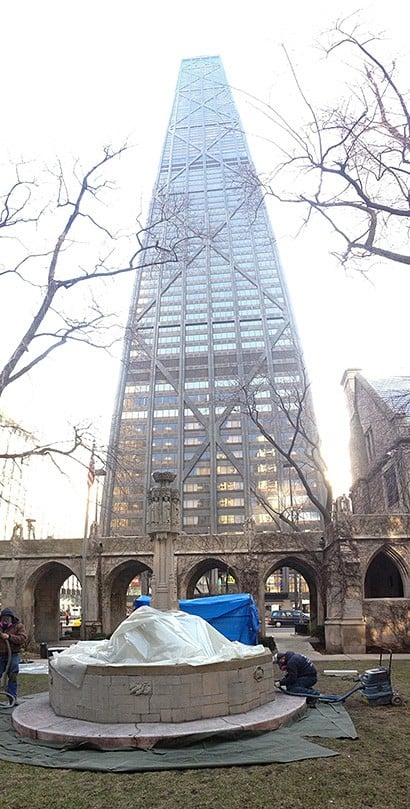
This spring, AAA-1 Masonry & Tuckpointing was granted the rare and distinguished honor of restoring the Fourth Presbyterian Church of Chicago's iconic hand-carved limestone fountain.
This beautiful century-old Howard Van Doren Shaw-designed limestone fountain sits in the courtyard just beyond the cloister fronting Michigan Avenue (formerly Pine Street during the time of its construction in what was considered to be a fairly undeveloped part of the city).
With the exception of the Chicago Water Tower, the church building is the oldest structure on Michigan Avenue and is listed on the National Register of Historic Places.
In 1884, the congregation worked with Rush Medical College to establish the city's Presbyterian Hospital (known from 1969 – 2003 as Rush-Presbyterian-St. Luke's Medical Center, and since 2003 as Rush University Medical Center).
Post: Water Leaks – Sound Familiar?
Thursday January 15, 2015
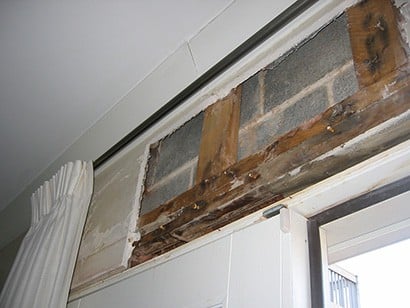
After a good wind-driven rain, without fail the AAA-1 Masonry & Tuckpointing switchboard lights up with calls from condominium owners experiencing water leaks. Over 95% of the time, those leaks occur over a unit owner's rear bedroom balcony door or transom in a newer condominium building constructed within the last 15 years.
Usually, owners first become aware of the problem because water has pooled on the floor or, worse, has warped or buckled the floor boards. Sometimes the leaks are so severe that owners observe a steady stream of water flowing out of the wall above their door frames or transoms during a storm. In the photo at right, we have removed the damaged drywall to reveal a very wet concrete block wall with no insulation and an improperly constructed wood stud wall.
So why does this happen? Factors contributing to the leaks invariably include the following:
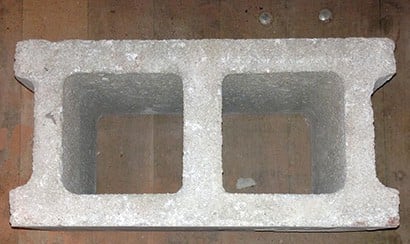
1. Extensive Use of Concrete Blocks in Lieu of Bricks
In the last 15 years or so, the use of high-quality brick has been replaced with larger, less dense and far more porous concrete blocks (aka Split Face Blocks). Developers like using these larger building materials because they drastically reduce the time required to construct a building's envelope. Depending on the depth of the block used, a single concrete block can replace the need to use up to 20 bricks. One concrete block versus 20 bricks?!? If you're a developer, the cost-saving choice is obvious. Usually developers will face the front of a building with more expensive and much denser brick in order to improve the building's curb appeal (any wonder, then, reports of water leaks in newer buildings are rarely reported on the front facade).
Not only is the density of the material used in concrete blocks far less than the density of the material used in traditional bricks, but concrete blocks are mostly hollow! (Refer to photo above right.) In general, wind-driven rain more easily passes through the walls of concrete blocks and therefore increases the likelihood of wet insulation, water stains, electrical shorts and damaged floors. That's bad!
2. Concrete Blocks Are Not Properly Sealed
Due to their porosity, concrete blocks need to be sealed. Sealants usually come in liquid form and are sprayed onto a wall. (Avoid applying sealants with a roller as this method does not effectively reach every nook and cranny of the block.) The type of sealant used and how much is applied makes a huge difference in its effectiveness and longevity. I will explain the differences between the many masonry sealants available in a future blog post, but know this: concrete blocks are not manufactured at the plant with sealant already in them. That's an urban myth — one that has been perpetuated by misguided real estate professionals and developers for nearly two decades. Due to the severity of Chicagoland's wind-driven wet weather events, concrete block walls must be sealed (after they are constructed), and this includes walls constructed with oversized utility bricks (which are nothing more than concrete blocks shaped to resemble bricks).
3. Improper Installation of Flashing
Flashing is a water-proof material used to direct water out of a wall. When properly installed, the flashing works as a barrier to prevent water from infiltrating the wall cavity and damaging your living space. When we do find flashing installed in concrete block walls, it is usually installed improperly or it is incomplete (e.g., the builder decided to install only 25 linear feet of flashing in a 50'-long wall). Well-intentioned developers are insisting their builders construct walls with the proper through-wall flashing detail over all window and door openings. Unfortunately, not all well-intentioned developers recognize a properly-installed flashing detail.
4. Installation of Deck or Balcony on Upper Floor
Very often there is deck or balcony one floor above the unit where the leak is observed. Look carefully and you will see that the deck or balcony is secured to the concrete block wall using through-wall fasteners called carriage bolts. Wherever you see a carriage bolt, water has the ability to infiltrate the concrete block wall and drip into the hollow wall cavity. Because most decks and balconies are built right up against the face of the building, it can be hard to see the water flowing down the carriage bolts and into the hollow concrete block wall…but it is happening!
What can you do to protect yourself from water damaging your home or investment?
1. Seal Your Building With the Best Masonry Sealant You Can Afford
The material should carry a written warranty and be applied when the masonry wall is bone dry. The sealant should have a moisture transmissivity rate >99%, which means the sealant allows the masonry wall to breathe while at the same time providing a hydrophobic barrier against wind-driven rain.
2. Request a Free Inspection from One of Our Licensed Mason Contractors
We are very qualified to determine whether your walls are properly sealed. We have applied millions of gallons of the highest-quality silane sealants to some of the finest masonry structures in the Chicagoland area. We know what works and the pitfalls to avoid if your building has been sealed in the past by a handyman or someone less qualified. Click here to request a free inspection of your walls.
From everyone at AAA-1 Masonry & Tuckpointing, thank you for your loyalty and trust.
—Rob
Post: Some Thoughts About Safety & Insurance
Thursday December 11, 2014
Just recently, I heard about the second fatal accident in Chicago in as many months involving unlicensed masons and improperly erected scaffolding. Had these men received the proper safety training, perhaps they would still be alive today.
All of AAA-1 Masonry & Tuckpointing's masons receive extensive and on-going safety training to protect the welfare of the workers, and the company is appropriately insured to protect the welfare of our customers.
Remember to always ask your mason for proof of insurance in the form a valid Certificate of Insurance (COI) before the job starts. On the COI there should be a phone number of the issuing broker, agent or company. Call that broker, agent or company and make sure the mason's coverages are, in fact, in place and the limits stated on the COI are, in fact, what the mason has on file with his insurance company. You do not want to discover after an accident that the certificate of insurance was fraudulent or had been terminated for non-payment or some other reason because that puts you—the innocent customer—at greater risk of being sued by the injured party.
If you have questions about what kind of insurance your masonry restoration should be carrying or the appropriate limits, please give us a call and we'll walk you though it.
Thank you for the opportunity to be of service!
